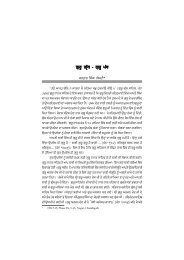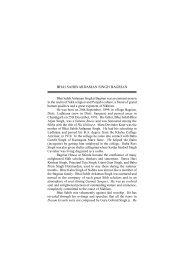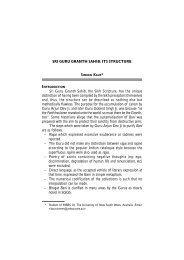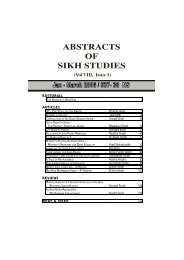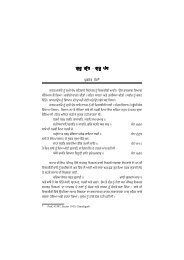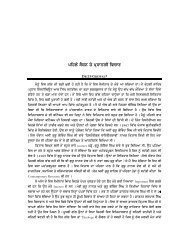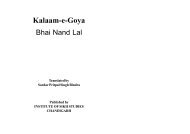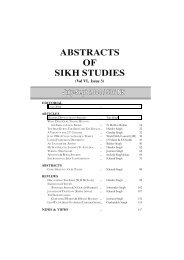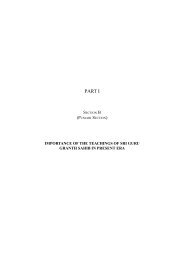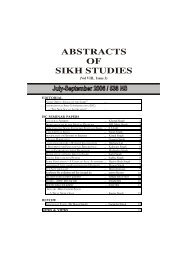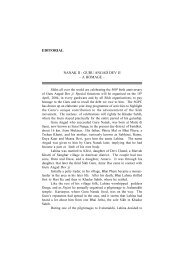editorial articles reviews news & views - Institute of Sikh Studies
editorial articles reviews news & views - Institute of Sikh Studies
editorial articles reviews news & views - Institute of Sikh Studies
Create successful ePaper yourself
Turn your PDF publications into a flip-book with our unique Google optimized e-Paper software.
18<br />
ABSTRACTS OF SIKH STUDIES : APRIL-JUNE 2005 / 537 NS<br />
modern era to search for the absolute reality. It contends that ultimate<br />
reality can never be found through senses and scientific instruments.<br />
According to Lyotard, scientific and rationalist discourses <strong>of</strong> the<br />
modern era have lost their legitimacy during the post-modern times.<br />
Quantum physics and chaos theory are some prime examples to<br />
demonstrate that science cannot make reliable predictions. Truth and<br />
reality transcend the obvious.<br />
GLOBAL PERSPECTIVES IN SCIENCE AND SIKH RELIGION<br />
Recent advances in both experimental and theoretical physics<br />
have established that quantum theory supports the idea <strong>of</strong> a cosmic<br />
spirit pervading the cosmos and inter-relationship <strong>of</strong> individuals in<br />
world society (parts and wholes). Roger Penrose in his book, Shadows<br />
<strong>of</strong> the Mind, has tried to establish the role <strong>of</strong> consciousness in new<br />
physics which looks beyond quantum theory. In the chapter, Structure<br />
<strong>of</strong> the Quantum World, he probes the limitations <strong>of</strong> the quantum theory<br />
to describe physical reality. Earlier, EPR paradox brought into focus<br />
the limitations <strong>of</strong> quantum theory : “The quantum-mechanical<br />
description <strong>of</strong> reality given by the wave function is not complete or,<br />
in other words, when the operators corresponding to two physical<br />
quantities do not commute, the two quantities cannot have<br />
simultaneous reality.” EPR paradox was explained by John Bell in his<br />
famous theorem implying some hidden variables. Theoretical<br />
predictions <strong>of</strong> Bell’s theorem have been verified by Aspect Experiments.<br />
The implications <strong>of</strong> Bell’s theorem and its experimental findings are<br />
staggering. They have established the interplay <strong>of</strong> consciousness and<br />
the physical world and changed our world-view where the notion <strong>of</strong><br />
an objective world is in conflict with quantum theory. The inter-relation<br />
<strong>of</strong> human consciousness and the observed world is obvious in Bell’s<br />
theorem. What we call physical reality, the external world, is shaped<br />
to some extent, by human thought. This train <strong>of</strong> thought was led<br />
further by David Bohm who proposed that the information <strong>of</strong> the<br />
entire universe is contained in each <strong>of</strong> its parts. For Bohm, order and<br />
unity are spread throughout the universe in a way which escapes our<br />
senses. We are living in a holographic universe. The world is an<br />
indivisible whole.<br />
Similar sentiments were expressed by John Donne, a mystic poet,



